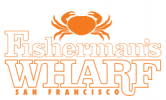the wharf’s fishing fleet
Most of the boats berthed at Fisherman’s Wharf belong to a third generation of fishing craft piloted by descendants of the fishermen, who have made their livelihoods on the waters of San Francisco Bay for many generations.

From the days of the Gold Rush until the turn of the Century, the San Francisco fishing fleet was composed of lateen-rigged sailboats, called feluccas. They were built in the same style as the boats the local Italian fishermen knew in their native land. Green was the prevailing color of the tiny boats, and the name of a patron saint usually appeared on the hull. The fishermen themselves were as colorful as their craft. Their natural talent for song was to be heard in renditions of arias from Verdi, lusty if not always true to the ear. In the fog-shrouded waters outside the Golden Gate, singing was a means of communication. You could not see a nearby boat in the fog, but from the song of its captain, you knew it was there.


The “second-generation” of fishing boats – Monterey Hull boats — came with the introduction of gasoline engines; small but dependable “putf-putts.” The gas engine made it possible to fish more days of the year, gave a wider range for their operation in the ocean water, and provided power to haul in the nets or lines. Today, several hundred of the Monterey-type boats remain as a part of the fishing fleet.
Often likened to the vintage automobiles of the Model-T era, the Monterey Hull craft ride at harbor alongside a “‘third generation” of commercial fishing boats — diesel-powered craft which overshadow them in size; cruising capacity and are often equipped with state-of-the-art technology. In the early day of Fisherman’s Wharf, the fishermen got their news about the weather from nature instead of a radio report. If the moon was in the east, the tide was coming in; or if in the west, the tide was flowing out the Golden Gate. A circle around the moon meant rain. Porpoises playing around the boat indicated a bad wind was brewing.
Old timers around Fisherman’s Wharf have other tales to tell about the hard work that fed their families. If the boat was becalmed, they waited long hours for a breeze, or got out the oars and rowed. Sometimes they would throw a grappling hook into the rudder chain of a passing steamer and get an easy ride home. When the steamer crews called out imprecations against these marine hitchhikers, the Italian fishermen screamed right back in words that soon became a part of waterfront.
In those earlier periods the favorite fishing spots were outside the Golden Gate, just beyond the waves breaking on the rocks and sandy beaches. It took great skill to manage the boats so they did not drift ashore and be wrecked. In terms of money, the rewards were very low. The average fisherman made $2 or $5 a week. But, on the other hand, a loaf of bread could be bought for less than five cents, and good red wine came from grapes that could be purchased for $5 a meal.
Today, as in the past, it is the fishing fleet, operated by the grandsons and great-grandsons of these past generations, which are the heart of Fisherman’s Wharf – a place of activity; the center of an marine-oriented industry beloved by native San Franciscans and visitors alike.






